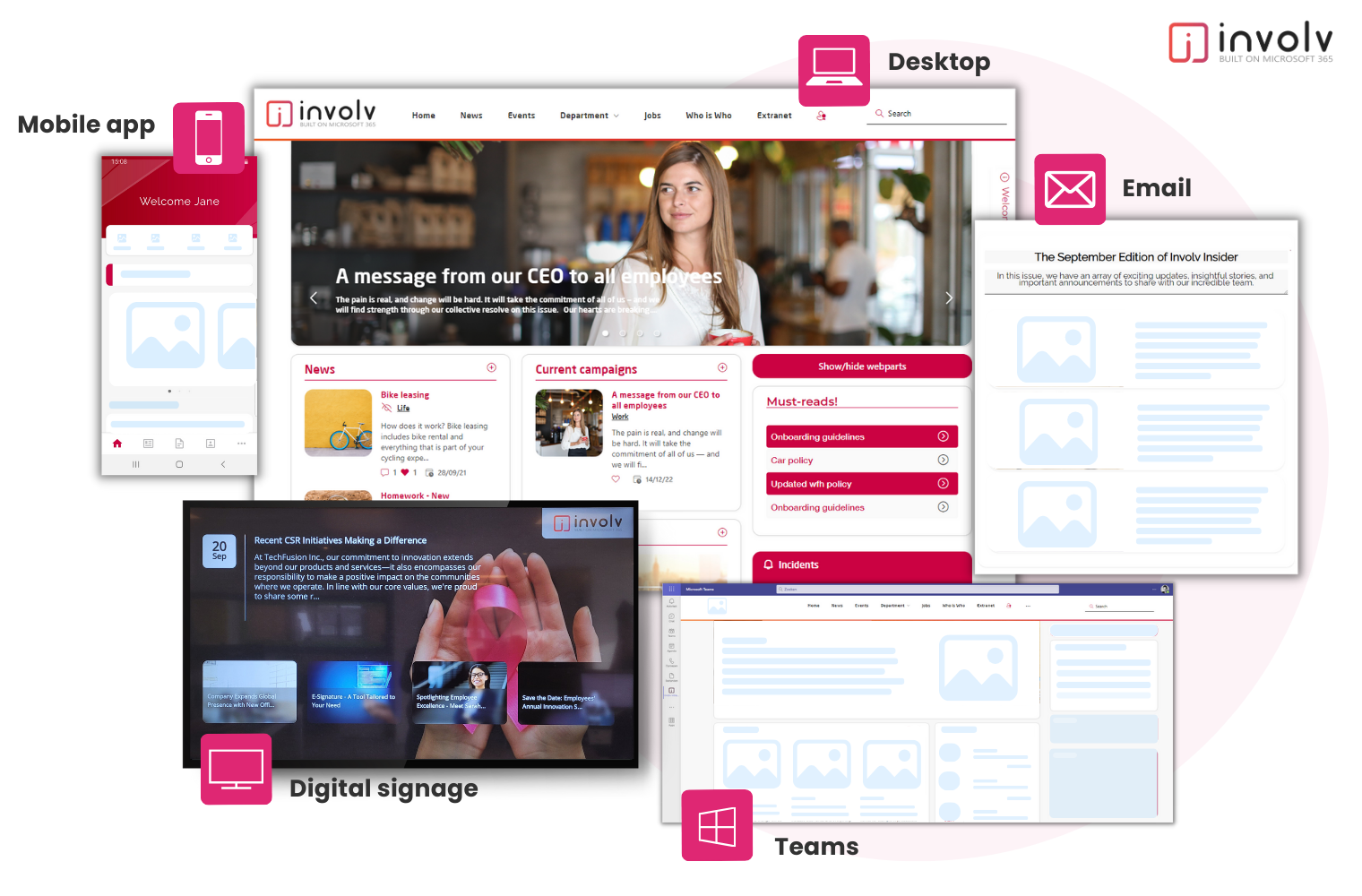Poor communication is the hidden enemy secretly destroying productivity, hurting employee happiness, and blocking new ideas at companies everywhere. And the scary truth is, it’s costing companies millions of dollars.
Inadequate communication to and between employees costs companies a whopping $62.4 million every year.
Numerous organizations face challenges with poor communication, spanning from top-down to bottom-up and cross-departmental channels.
Before sharing ways to improve your internal communication, let’s examine the true cost of poor communication in the workplace.
What is the impact of poor communication in the workplace?
From wasted time to unmotivated teams, the consequences of poor communication are vast and far-reaching.
Here are 5 painful problems you’re inevitably setting yourself up for by letting communication fail:
1. Hours wasted hunting for info
When information isn’t shared clearly, employees lose 30% of their time (2.5 hours daily!) just desperately searching for what they need to do their jobs.
Making matters worse, poor communication leads to inbox overload as people MESSAGE to fill the void. So they’re drowning in both scattered info and a tsunami of emails, burying vital updates and strangling productivity.
2. A disjointed, misaligned workforce
Strong communication ensures everyone understands the company vision and goals, and what’s expected of them.
With poor communication? Mass confusion about priorities, with people rudderless and unmotivated. It’s like a boat where every rower is going their own way.
3. A toxic company culture
Good communication breeds the transparency and trust that positive cultures are built on.
Poor communication? You guessed it – it destroys trust in leadership and engagement. Morale plummets as people become unhappy, unengaged flight risks.
4. Siloed teams and zero collaboration
Poor communication is the enemy of collaboration, with information trapped in team siloes.
So teams unknowingly duplicate work or work against each other as vital knowledge stays locked away. Without communicating, the cross-pollination of ideas that drives innovation simply can’t happen.
5. Costly mistakes, rework and delays
Bad communication causes mistakes. Missing info leads to errors. Redoing work wastes valuable time and money.
When instructions are unclear, employees guess and mess up projects. Mistakes require redoing work, missing due dates, and hurting quality for customers.
Planning your intranet project
Planning a new intranet project? What steps to take to build an effective intranet? Download our free whitepaper.
4 ways to fix poor communication in the workplace
1. Build an open sharing culture
In today’s dispersed, hybrid environment where teams are spread across locations and time zones, working in isolated departmental siloes is the kiss of death for effective communication and collaboration. Fragmented communication inevitably leads to duplicated efforts, inconsistent messaging, and the toxic culture of second-guessing and mistrust that festers when knowledge isn’t freely shared.
But you can tear down those unproductive siloes and unlock the power of open communication by:
- Timely sharing important news and updates company-wide through channels like intranet newsfeeds, newsletters, and push notifications. Involv intranet allows you to send push notifications to the mobile app, Microsoft Teams, and email for any important content.
- Encouraging open cross-department dialog for sharing wins, challenges, and peer recognition. Use intranet tools like discussion forums, social sharing, and document collaboration on a platform like Involv.
- Creating transparent leadership communication through methods like intranet blogs for stories/recognition.
- Holding regular Q&As, town halls, and surveys to promote two-way dialog and keep your ear to the ground.
- Providing open ideation spaces and crowdsourcing tools on your intranet for collaboration and exchanging ideas. Involv intranet has an ideation tool perfect for this purpose.
- Centralizing resources and tools in one location, like a modern intranet, to avoid duplicated work and scattered info.
2. Keep your communications clear, consistent and regular
Your colleagues are overloaded with emails, chat messages, meetings, and digital noise everywhere. It’s really hard to get your message heard through all that chaos. You want people to not just see your communications, but truly understand and act on them.
The key is keeping things simple, clear, and consistent. Use plain language, visuals, and stick to a regular schedule. When your communication is straightforward and predictable, it’s much easier to cut through the clutter.
High-performing companies are twice as likely to keep communications
simple and jargon-free.
Here are some best practices:
- Use jargon-free language tailored to your audience’s level. Clarity prevents misunderstanding and confusion.
- Incorporate visuals like icons, images, and video to enhance engagement. Our brains process visuals faster for better comprehension.
- Creating transparent leadership communication through methods like intranet blogs for stories/recognition.
- Keep core messaging unified across all channels via multi-channel publishing tools such as Involv intranet. Consistency prevents mixed signals and misalignment.
- Establish one “source of truth” channel for important announcements and resources (e.g. your intranet). Having a centralized hub avoids searching and conflicting info.
- Provide regular updates to foster transparency and goal-alignment while combatting rumors. Frequency reinforces key messages.
Simple, consistent, regular communication eliminates the chaos, confusion, and gaps that lead to poor communication.
3. Listen and take action
The best communicators don’t just broadcast – they promote open, two-way dialogue. They understand that listening is just as critical as speaking up. Shut out employee voices and you’ll end up with an insular, disconnected organization.
So break free from corporate echo chambers. Give your people a voice and make sure they feel truly heard.
- Use short pulse surveys and polls to quickly gather candid insights and feedback. Intranet survey tools like Involv Polls make this a breeze.
- Create “idea hubs” or open forums where employees can share suggestions, discuss challenges, and provide continuous input – not just during annual reviews. An intranet ideation tool works perfectly for this.
- Encourage team-specific spaces on your intranet for sharing status updates, celebrating wins, and surfacing roadblocks.
- Maintain regular channels for two-way communication, such as Q&A sessions and town halls, and consider implementing check-in meetings to ensure everyone’s voice is heard.
Most importantly, you have to visibly act on the feedback. Asking for opinions then ignoring them is a surefire way to kill motivation and breed disengagement. Employees need to see their voices are valued.
Build active listening and dialogue into your culture. It’s the ultimate way to break down communication barriers.
4. Train for communication excellence
Let’s face it – not everyone is a naturally gifted communicator. Public speaking, writing clearly, running effective meetings…these are all skills that require development and practice.
But you can absolutely coach your teams to achieve communication excellence. With the right training program and reinforcement, you’ll have a workforce of masterful communicators. Here’s how:
- Host webinars and provide bite-sized videos/courses on crucial skills like presentations, writing, facilitation, and giving feedback. Having a central training hub on your intranet makes these resources easy to access.
- Enable mobile learning by publishing training content to your intranet’s mobile app. That way, anyone can build skills during commutes or downtime.
- Make trainings hyper-relevant by tailoring content for specific roles and departments. For example, courses on improving marketing/sales alignment.
- Reinforce through continuous methods like Q&A forums, wikis highlighting best practices, and recognition for top communicators.
- Outline clear guidelines on how and when to use each communication tool. That way, no one defaults to the wrong medium.
An intentional skill-building program, combined with a modern intranet full of peer resources, quickly becomes a breeding ground for outstanding communicators across your company.

Make your intranet your communication powerhouse
In today’s fast-paced work environment, poor communication is an expensive bottleneck that strangles productivity and innovation. Don’t let miscommunication hold your organization back any longer.
By utilizing the full capabilities of your modern intranet, you can tear down communication silos, keep everyone on the same page, encourage open dialogue and empower your people to communicate with clarity and purpose.
Get started transforming your intranet into a powerful communication engine today. When everyone is delivering messages with impact, there’s no limit to what your business can achieve.
Explore the future of intranet solutions with Involv. Learn how our team of experts can help you create an effective internal communications platform and tackle today’s business challenges.






